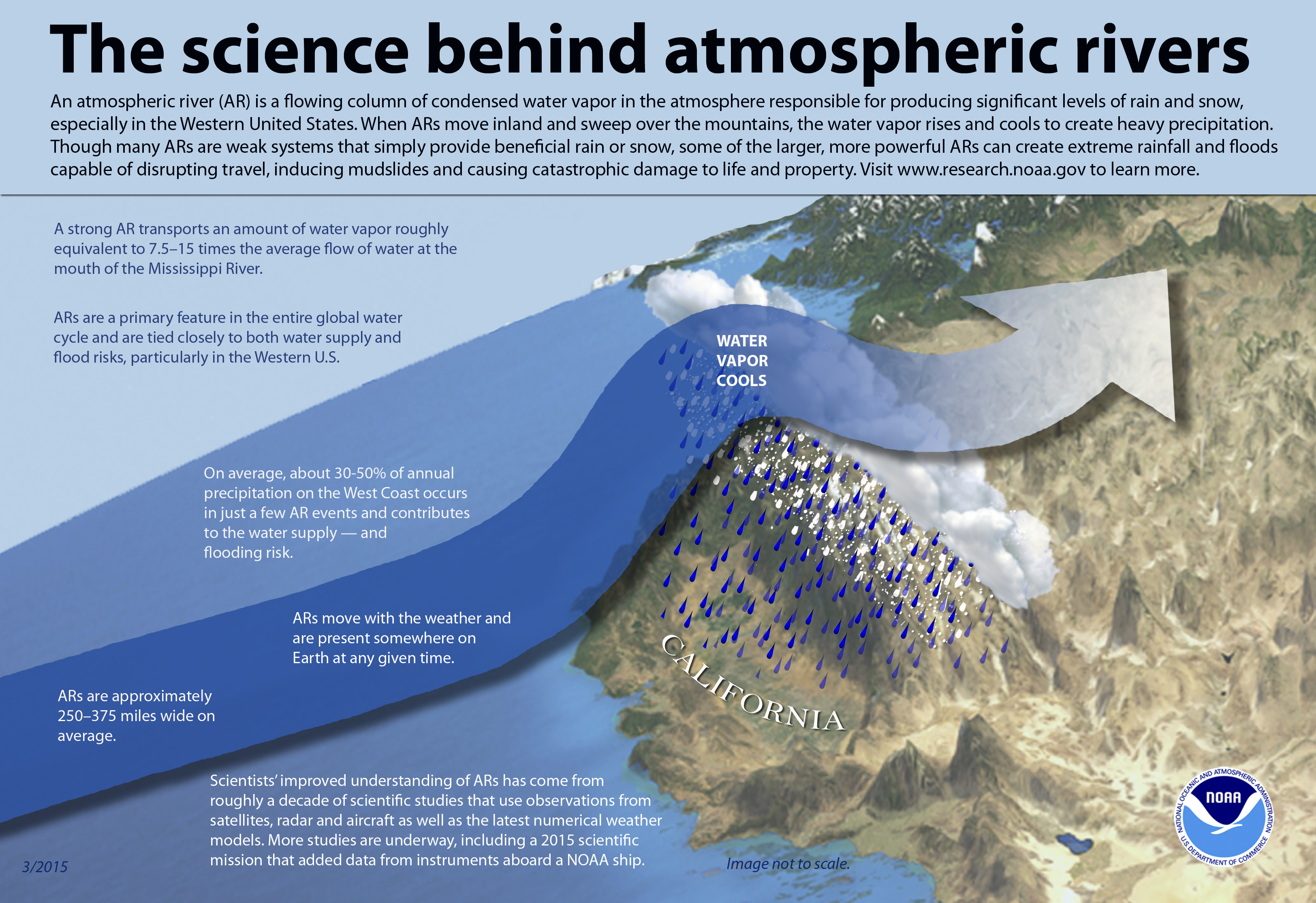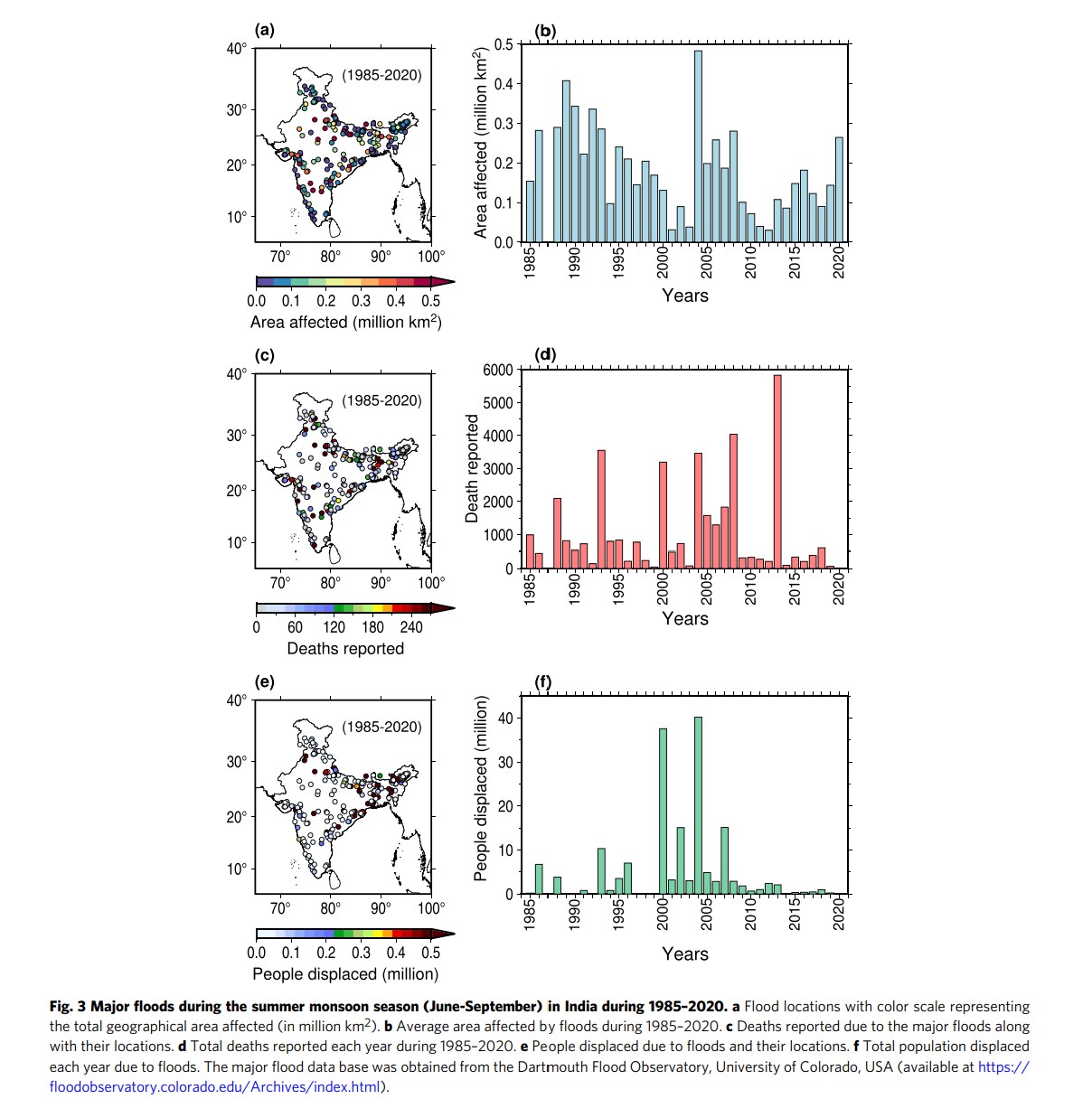
The summer monsoon rainfall, the lifeline for agriculture and water resources in India brings along with it heavy bursts of showers from the moisture-laden winds that originate near the equator. But extreme rainfall events are now increasing in the Indian subcontinent during the monsoon season - leading to massive flooding causing deaths and damage to property, resources and livelihoods.
While climate change is to blame, what triggers increase in influx of moisture laden winds to the subcontinent and worsening the situation is surprising - landfalling atmospheric rivers (ARs) - which are known to play a role in triggering extreme rainfall events and floods, say scientists.
What are atmospheric rivers
Atmospheric rivers (ARs) are large, narrow sections of the Earth’s atmosphere that carry moisture from the Earth’s tropics near the equator to the poles. The Earth has around four to five active atmospheric rivers that carry massive amounts of moisture. They release moisture when they reach land, producing heavy snow and rain.

Atmospheric rivers can vary greatly in size and strength, and can carry water vapor roughly equivalent to the average flow of water at the mouth of the Mississippi River and even upto 15 times that amount in exceptional circumstances. The play a major part in the formation of clouds and therefore have a significant influence on air temperatures and other climatic factors and are critical to plant and animal life, agriculture, and people as sources of water. However, atmospheric rivers can also cause severe flooding due to the massive amounts of precipitation they release.
The rapidly changing climate is causing shifts in atmospheric rivers resulting in an increasing number of extreme weather events world over. Conditions such as strong low-level winds that aid in the transport of water vapour, high moisture levels, which are a prerequisite for precipitation to occur, movement of air mass from a low to a higher elevation influence the formation of atmospheric rivers. As the air mass gains altitude, it quickly cools down, raising humidity in the air and eventually leading to the formation of clouds and, under the right conditions, leads to rainfall
Atmospheric rivers are important as they provide water security for communities and keep the water cycle in balance. They aid in redistribution of freshwater supply, increase water levels in watersheds, promote ecosystems, biodiversity, replenish groundwater reserves. But they can also cause landslides, mudslides, and major flooding. Lack of atmospheric rivers can also result in droughts, which are associated with food insecurity and shortages as well as increased human conflicts.
Atmospheric rivers and their linkages to flooding in India: What does evidence indicate?
While flooding due to extreme precipitation has substantially increased in India, the role of atmospheric rivers in triggering this flooding continues to be unknown informs this open access study titled 'Atmospheric rivers that make landfall in India are associated with flooding' by Mahto S S, Nayak M A, Lettenmaier D P, Mishra V published in Nature.
An examination of the occurrence of Atmospheric rivers (ARs) and their linkage with major floods in India in this study over the last 70 years shows that:
India has experienced many AR events
India has experienced 596 major AR events from 1951–2020, totaling 1520 AR days. More than 95 percent of these ARs occurred during the summer monsoon season (June-September) while only about 4 percent of total happened during the non-monsoon season during the 1951–2020 period. During the summer monsoon, ARs occur about 28 percent of the days in July, followed by August (22 percent), June (15 percent), and September (6 percent).
Strong seasonality in moisture transport during the monsoons triggers AR occurances. For example, vertically integrated vapor transport (IVT) is low during January-May, but rapidly increases during the monsoon season. The eastern part of the Indo-Gangetic plain and peninsular India experience higher IVT i.e. vapour transport than the other regions. This leads to higher frequency of occurrence of ARs in the lower Indo-Gangetic plain and peninsular India during the summer monsoon season.
The increase in IVT during the summer monsoon season has been found to be associated with warming climate that accelerates anomalous moisture uptake leading to the rising trend in the frequency of ARs. The Arabian Sea, northern India, and peninsular India experience a significant increase in the AR frequency during the summer monsoon season.
The contribution of ARs to Indian summer monsoons is significant
ARs contribute about 13 percent of India’s summer monsoon precipitation. Their contribution is slightly higher (more than 16 percent) over central India and western Ghats compared to other parts of India.
The total precipitation contribution from ARs during the summer monsoon season has significantly increased during 1951–2020. About 18-24 percent of the total extreme precipitation over the Indian land mass was related to ARs during the 1951–2020 period with a more prominent contribution in the Western Ghats and Central India.
The frequency and severity of ARs show an increasing trend
Out of the top 1/3rd AR events, 54 percent occurred in the most recent three decades (1991–2020) with a severity 10 percent higher than the average severity score of all ARs.
Both the maximum and mean IVT of ARs over land have also increased significantly over 1951–2020 at a rate of ~1 kg m−1 s−1 and 0.3 kg m-1 s-1 per year, respectively with the most prominent increase over the Indo-Gangetic plain and peninsular India
Moisture-carrying wind plays the most prominent role in determining the IVT anomaly during ARs, with about 90 percent contribution to IVT. The remaining 10 percent is contributed by specific humidity. Both wind speed and specific humidity have significantly increased in the summer monsoon season during the 1951–2020 period. The strengthening of moisture carrying winds and increased humidity have contributed to increasing mean summer monsoon IVT in India. Enhanced evaporation from the ocean caused a rise in specific humidity, which led to increased IVT over the Indian region and thus increase in ARs.
The linkages between ARs and flooding in India
The percentage of flood-associated ARs in last two decades has been found to be as high as 72 percent. Among the most severe ARs (top 1/3rd) in post 1985 period, 63 AR events occurred in the last two decades of which 82 percent were associated with floods. The severity of flood associated ARs was higher in the last two decades (2003–2020) compared to flood-associated ARs in the 1985-2002 period.

Out of the ten floods during 1985–2020 that caused the highest mortality, seven (in 2013, 2007, 1988, 2018, 2006, 1993, and 2004) were associated with ARs. The most devastating floods during 12-27th June 2013 in Uttarakhand took around 6000 human lives was associated with ARs leading to two highest rainfall days on 16-17th June 2013.
ARs also caused floods in 2007 (July-August) and 1988 (September), with extreme loss of life over the eastern and northwestern parts of India. Similarly, the September 1988 event, caused by an AR, led to especially disastrous floods in the Punjab. The other two major flood events that led to extreme loss of life affected the western peninsular regions of India included the Kerala floods and that in southern part of Gujarat due to the 2006 AR.
The 1993 severe floods in the Indo Gangetic plain and Assam were triggered due to extreme rainfall due to an AR in July 1993. Similarly, AR in 2004 contributed to hazardous floods in Eastern India and Bangladesh while other major flood events in the summer monsoon season associated with landfalling ARs occurred in 2000, 2008, and 1985.
As high as 70 percent of India’s major flood events in the summer monsoon season were directly associated with ARs during the 1985–2020 period.
Floods have devastating impacts on lives, the economy and livelihoods and understanding the role of ARs in future climatic events can be crucial to devise resilience building mechanisms to floods. The study argues that ARs should be factored in as an integral part of the existing flood early warning systems in India to aid in adaptation and mitigation.
/articles/rivers-sky-are-triggering-extreme-flood-events-india